380th Bomb
Group Association
World War II Veterans Group
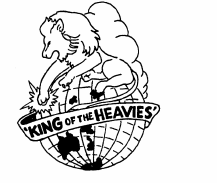
|
380th Bomb
Group Association |

|
According to the 380th records/history, there were four chaplains assigned to the Group:
• Carroll, Anthony G., O-386674 (to 380th 23 July 1944)
• Leger, Herbert J., O-503272 (to 380th 3 January 1945)
• Roark, Harry M., O-472682 (Initial Deployment, May 1943)
• Trent, B. C., O-522898 (380th entry date unknown)
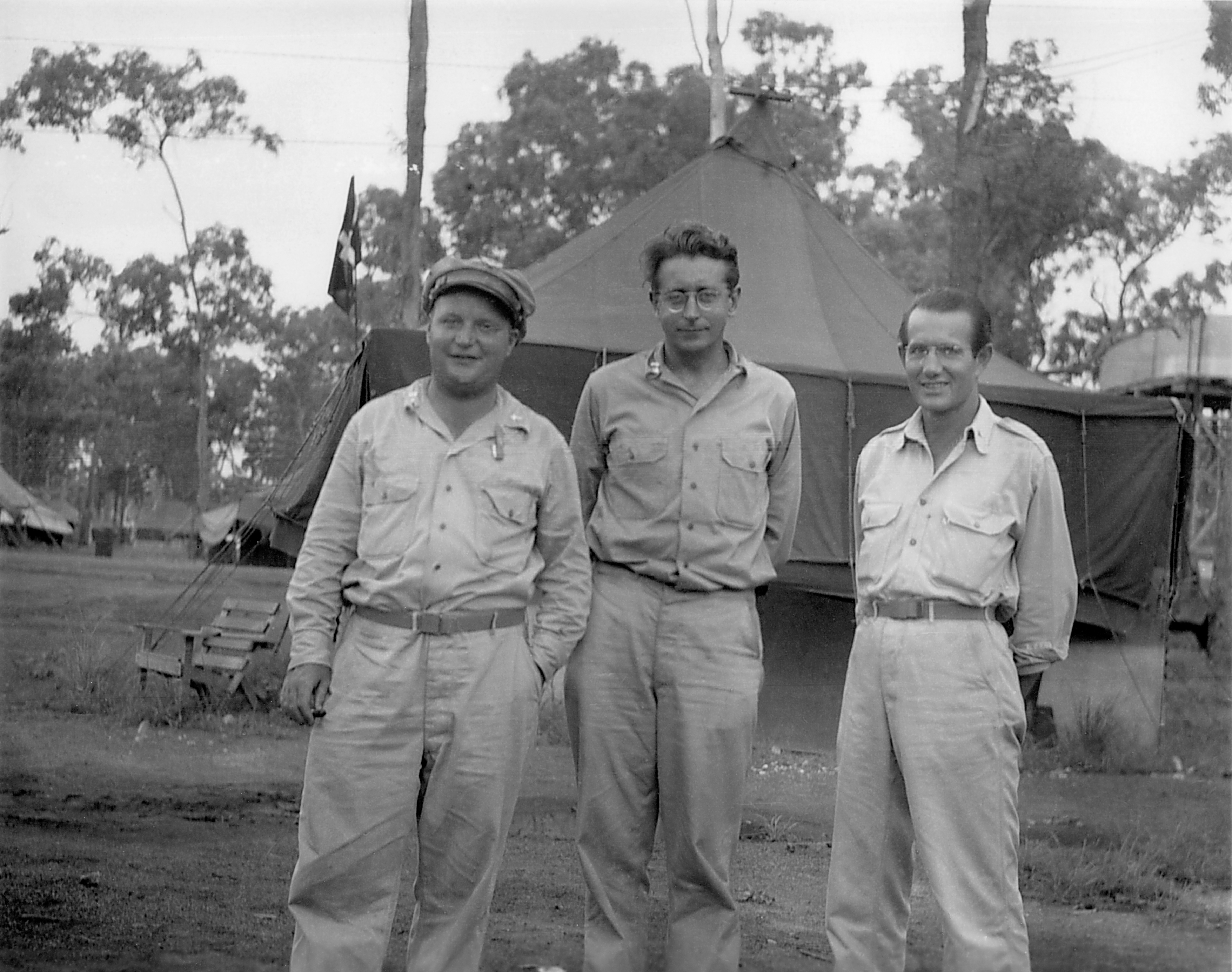
Chaplains Waldo, Carroll, Roark (Waldo was not with the 380th, visiting at the time of this photo)
Carroll, Anthony G., Jesuit Chaplain
Born 9 Aug 1906, entered Jesuit society 14 Aug 1922, ordained 23 Jun 1935, died 1972 in Dallas, Texas.
Appointed to Army 12 Jan 1940. To the rank of Captain 24 Apr 1942; to Major 12 May 1945.
Assignments: from 1942 to 1945 served with Army Air Force Units in Australia, New Guinea, Philippines and Japan. Served in the United States and overseas with 102nd Coast Artillery.
Overseas with the following units: 380th Bombardment Group; 8th Fighter Group; 5th Fighter Command. Reverted to inactive status 9 Nov 1946.
Taught at Boston University before the war. He was in the Pacific for some time prior to the 380th’s arrival and was flown in light planes from island to island ministering to the needs of natives, as well as others.
Leger, Herbert J., presumed to be second Catholic Chaplain
Born 1 April 1906, Lynn, Massachusetts, died 31 Jan 1992, Boston, Massachusetts.
It is believed that Leger was the Catholic priest who replaced Father Carroll. Little is known about him or his service with the 380th, other than he arrived at the 380th on 3 Jan 1945.
What is known from records found on Fold3 is that he enlisted on 29 Nov 1942, hometown Essex, Massachusettts, and at the time of enlistment he was working at St. Joseph’s Parish (Catholic church) in Essex. He was released from active duty 2 Mar 1946.
Roark, Harry McCullar, Baptist Chaplain
Born 6 March 1912 near Duncan, Oklahoma; married Oma Boggs in Duncan, Oklahoma, November 23, 1932; he died 6 June 1997 in Shawnee, Oklahoma.
B.S. degree at Oklahoma Baptist University; Th.M. at Southwestern Baptist Theological Seminary, Fort Worth, Texas
Entered USAF in Wichita Falls, Texas, and went to Chaplain’s school at Fort Ben Harrison, Indiana. From there went to Biggs Field as Base Chaplain.
One of the first assigned to the 380th Bomb Group which was put together at Biggs Field, and went overseas with the group.
He was at Fenton Field, Mambaloo, and Pinehaven. Conducted services at all these places as well as for some smaller groups. Sometimes he had 9 services on Sunday and 15 in a week.
Col. William Miller was 1st C.O.; Roark had the privilege of being in every major city in Australia, also many of the islands.
Left the 380th in the Philippines and became Chaplain of the 417 Bomb Group (A20 outfit). He was in Pearl Harbor on his way home when the war ended.
After the war he went to Central Baptist Theological Seminary at Kansas City, Kansas, and finished his Th.D. degree.
He pastored the First Baptist Church in Blackwell, Oklahoma, for 13 years and then at the First Baptist Church in Gainesville, Texas, where he was pastor for 21 years.
He retired in 1981; after retirement, he served 2 terms as Mayor of Gainesville, Texas, and served on a number of boards and committees, both within the denomination and hometown and city.
Trent, B.C., Protestant Chaplain
Born in Hancock County, Eastern Tennessee, 8 October 1917.
Graduated Hancock County High School, Morristown, Tennessee, in 1935. Graduated Texas Wesleyan College, Fort Worth, Texas, and entered the Chaplain Corp, U.S. Army, 1943.
Assigned to the Army Air Corps; released from active duty December 1946.
Recalled 1951; served in Korea. finishing his career as the PACAF Command Chaplain during the Vietnam War. He retired in 1973 and moved back to Eastern Tennessee; he died 17 December 2000, Morristown, Tennessee.
First assignment in 1943 was to the Chaplain School, Harvard University. After that assigned to Drew Field, Tampa, Florida. From there moved to a Signal Air Warning Battalion in Hattiesburg, Mississippi, to Camp Pinedale, California, and then to New Guinea. Moved from New Guinea to the Halmahera Islands, and from there to Luzon in the Philippines. Joined the 380th Bomb Group on Mindoro (replacing Roark). He was able to have a chapel built on Mindoro (of ships’ dunnge and nipa palm leaves). Trent moved with the 380th to Okinawa, and from there to Japan.
Left Japan in December 1945, assigned to Chanute Field, Illinois, until December 1946. After released from active duty, attended Yale University Divinity School and soon after graduating he was recalled to active duty in 1951. His assignments ranged from Scott Air Force Base (Illinois), Alaska, Lackland AFB (Texas), Enid (Oklahoma), Maxwell AFB (Alabama) where he was one of the original members of the Chaplain Writers Board, and Greenham Common Air Force Base (England).
Upon return from England, he was assigned to HQ 15th AF, March AFB (California), from there to Hamilton AFB (California), and on to HQ ADC, Colorado Springs, Colorado, where he was Command Chaplain. His last assignment was Command Chaplain at HQ PACAF Hickam AFB, Hawaii.

Chaplain B.C. Trent
Sources:
• Information and photos provided by Glenn Rogers, from his correspondence/interviews with Charles E. Schroeder, Harry Roark, and B.C. Trent.
• 2014 To Love and Serve: World War II Chaplains of the New England Province of Jesuits, by Joseph P. Duffy S.J.: https://crossworks.holycross.edu/cgi/viewcontent.cgi?article=1004&context=nenprovhistory
• Ancestry, fold3.com
• Find a Grave website
• 380th.org (Group Roster)
• Modern Anglican church photo from Robert Livingstone
June 17, 2020, NOTE from GLENN D. ROGERS (HONARY 380TH CHAPLAIN)
It was my privilege to serve as a Chaplain to the 380th Bomb Wing while stationed at Plattsburgh AFB from 1985-1988. It was my first assignment in the USAF, and I became fascinated in the history of the 380th Bomb Group of WWII. I volunteered in the PAFB Museum, and especially tried to find information on the chaplains assigned to the Group. There were few records, and the USAF wing historian told me, with a bit of a sneer, that "Air Force history" generally did not include such "unimportant people" as chaplains.
In September of 1986, the 380th WWII vets held a reunion at Plattsburgh. I served as an official escort. I learned many stories from these great guys, but I was especially happy to learn the names of Chaplain Harry Roark and Chaplain Tony Carroll, the original Protestant and Catholic Chaplains. Father Carroll had died some years before, but I was able to track down Chaplain Roark, and persuaded the Wing Commander to invite him to be the speaker for our annual base observance of the National Prayer Breakfast.
As a result, I was able to spend about three days with Dr. Roark, who regaled me with stories of his experiences as the chaplain, and gave me wonderful insights into the men he served. In those days, the chaplain was present at every pre-flight briefing and every senior staff meeting, and was the confidant of men of every rank and job. He had one of the most comprehensive observation points of anyone in the unit.
From what I learned from the vets, Roark and Carroll were tireless, proactive chaplains, whose ministries permeated the 380th. Chaplain Roark told me that he and Father Carroll were tentmates, worked well together, and grew to be close friends. They were both serious pastors, and shared a common view of that role, albeit from their differing theological perspectives. They both agreed that they would be ineffective unless they faced the same dangers and hardships of their flock.
In view of this, they persuaded the Group Commander, Lt. Col William Miller (whom Chaplain Roark profoundly admired), to allow them to fly on several combat missions. As Chaplain Roark said, "We knew that, if we didn't face the flak, we would never have the respect of the men who did." Col Miller had two stipulations: the chaplains would have to fulfil a real job on the aircraft (they were waist gunners) and they could only fly on Col Miller's own crew -- that way, if they got shot down, Col Miller wouldn't have to explain why they were on board against AAF regulations.
In October of 2004, soon after my return from Iraq, I was serving as Wing Chaplain at Hanscom AFB near Boston. I received notice that the 380th was going to hold a reunion there, and was requesting a Memorial Service in our base chapel. Rather than assigning it to one of the younger chaplains, I grabbed the opportunity to lead the Memorial Service myself. When the vets arrived, I began to give the message by relating some stories that I had learned from Chaplain Roark, and the vets sat there in amazement, wondering how I knew about those things.
When I told them, I was received as an old friend, and invited to the banquet that was held later that week. At the banquet, I was presented with a 380th Bomb Group jacket, and declared to be an honorary chaplain for the group. Sadly, very soon thereafter, I learned that my wife was dying of cancer, so I had to relocate to California to care for her and her 95 year old father, so I never got to attend any more reunions.
I hope, therefore, that I will be able to thus contribute a little bit to the knowledge-base of the group, and hopefully preserve the important history of these great men.
Glenn D Rogers, Ch, Lt. Col, USAF (Ret)

Rogers at the 380th's 2004 Boston Reunion
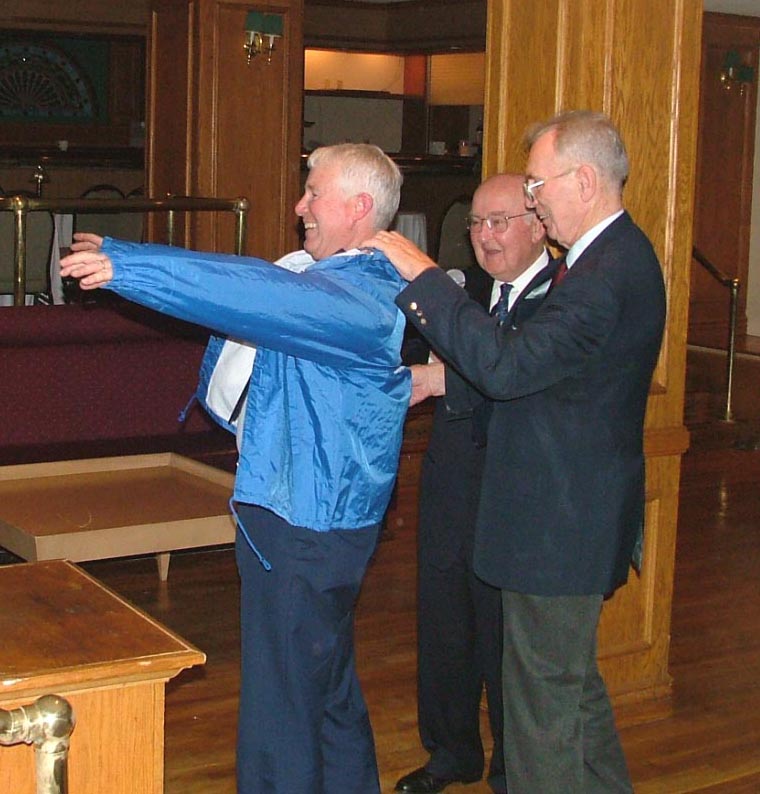
"Jacket Ceremony," Glenn Rogers, Tom Hunt, Ted Williams
NOTES AND PHOTOS FROM GLENN ROGERS' INTERVIEWS WITH ROARK
ABOUT FATHER CARROLL
Although Father Carroll was only with the 380th for about a year, Chaplain Roark and he became great friends. Now that they are both gone, I can tell you a wonderful story that Chaplain Roark told me.
Anthony "Tony" Carroll was a Jesuit priest, from Boston, who "entered the Society" at age 16 and attended Jesuit schools through Seminary. Roark remembered him as a quiet, gentle man, who cared deeply for his men and served them as a faithful pastor -- traits I have learned also characterized Roark. Roark remembered Carroll having served as a missionary right out of Seminary, four or five years before being sent to the Army in 1940.
Roark was the fifth officer on the list of the 380th; Carroll joined him in Australia. The fact that they had both a Protestant and Catholic chaplain in the 380th was probably due to the remote circumstances of their service.
Because he had been a Jesuit all his adult life, Father Carroll had never actually had a paycheck, and had no experience of the need for money to provide for himself. However, he did enjoy a few pleasures, one of which was playing cards. Sadly, he wasn't a very good card player, but being very good natured, and enjoying the company of friends, and (worst of all) having little sense of the value of money in terms of paying for his food, clothes and other needs (as officers were required to do) he thought it was great fun to play cards even as he lost every penny of his paycheck. The Ops Officer, however, DID understand the value of money, was a very good card player, and, more than once, cleaned kindly Father Carroll out of his cash.
The Ops officer was, however, of Southern Baptist background, like Chaplain Roark, so Roark would march up to the Ops Officer's tent and demand that he return Father Carroll's money, giving him a stern lecture on the evils of gambling, etc. He got most of Father Carroll's money back.
I don't know how often this happened, but when Roark told me the story he could barely speak from laughter. I think it was one of Chaplain Roark's favorite memories of his time with the 380th, but, being a kind and diplomatic gentleman, not one he could relate to very many people.
PHOTOS

This is the chapel that Trent and the men built on Mindoro, The Philippines (of ships’ dunnge and nipa palm leaves)
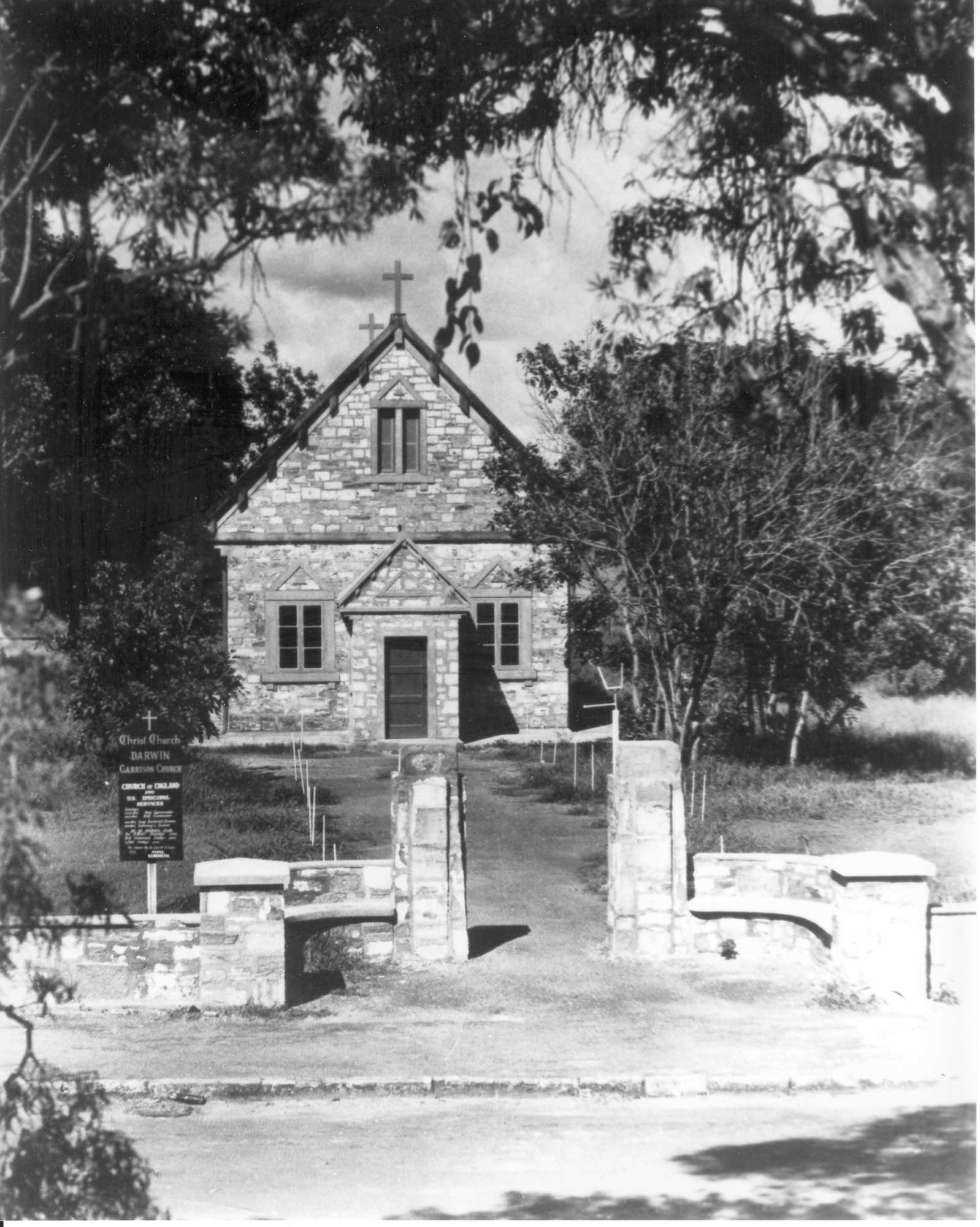
This is the Christ Church Anglican Chapel in Darwin, which offered services to the more "liturgical" Protestants (Episcopalians and Lutherans) and was used by the Catholic chaplain on occasion.
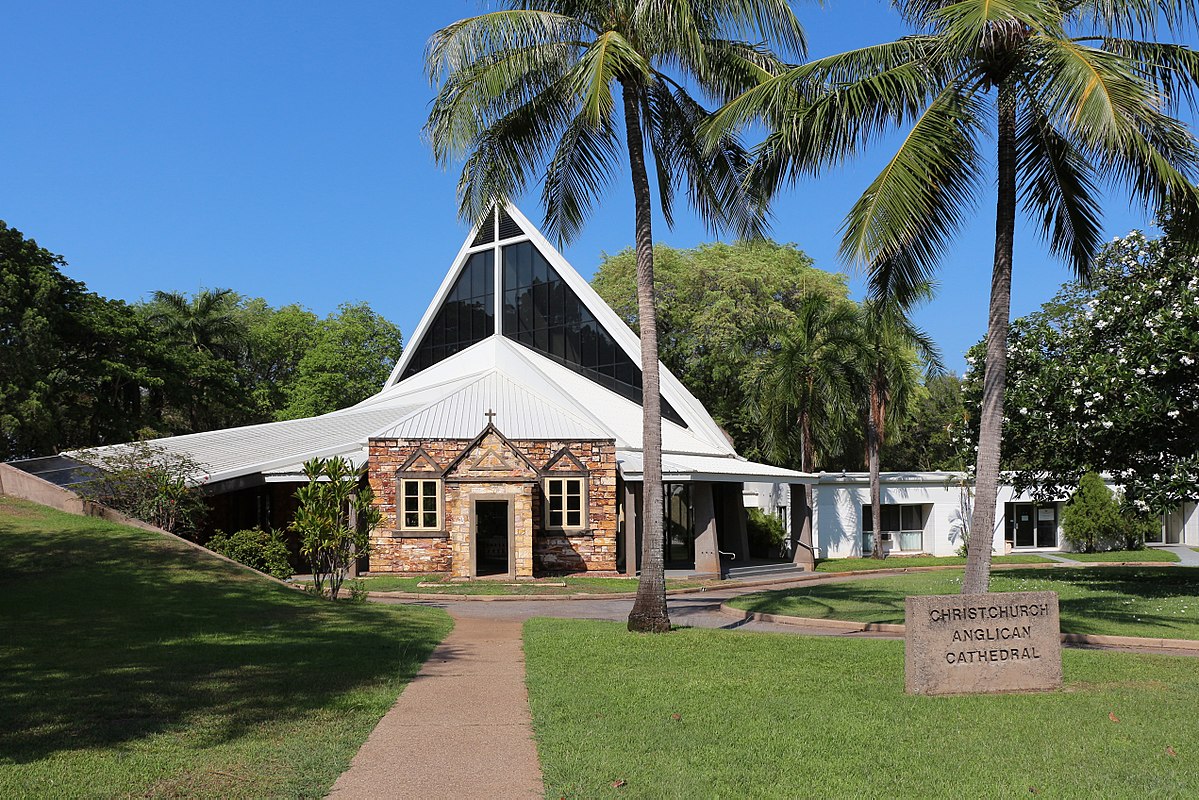
According to Bob Livingtone, the wartime Anglican Chapel shown above was almost totally destroyed by Cyclone Tracy in 1974. A very modern-looking church has been built in its place and you can see in this image that the porch from the old church was incorporated into the new building. (This photo was sent by Livingstone.)

Chaplain B.C. Trent; Easter Service, April 4, 1945; service outdoors before the chapel was completed

Easter Catholic Mass; this is the Catholic priest who replaced Father Carroll (name unknown, perhaps it was Herbert J. Leger)

Another photo of Trent's Easter Service 1945
Rogers sent some photos that were in the Memorial Chapel in Plattsburgh, which included the pictures of the chapel in Mindoro and of the Easter Services with Chaplain B.C. Trent. There was no detailed explanation with the photos, other than a small sticker identifying that it was the 380th Bomb Group in the Philippines. While at Plattsburgh, Rogers spoke to BC Trent (he'd been retired for many years) on the phone. He recognized them from my description, and was able to identify them as Easter, but he didn't remember the photo of the Colonel, and he couldn't give Rogers a date for the construction of the chapel.
This image has been tagged as Col Brissey, from comments made by Chaplain Roark. Roark thought the world of Col Miller. He was (diplomatically) less enthusiastic about Miller's successor. Chaplain Roark left the 380th about the time they moved to the Philippines and soon after Col Miller's departure and Brissey's taking command.

Col. Forrest L. Brissey (Group Commander 1944-1945) at the dedication of the chapel on Mindoro
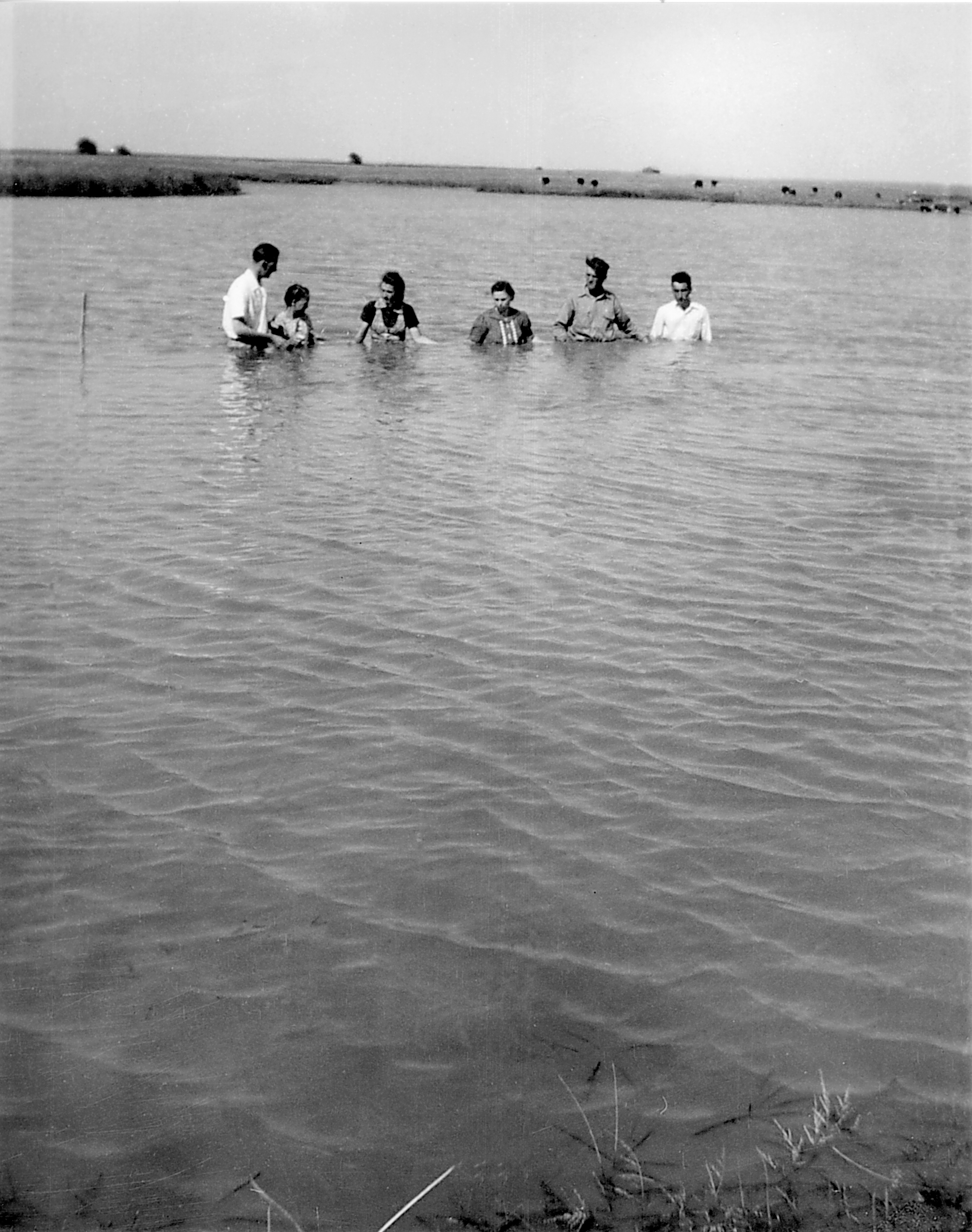
Baptismal service in the Pacific

Fenton Field Gravesite of Capt. Samuel S. Poor, Jr.; he died in a flying accident on 25 August 1943 at Fenton Field

Christian women place one of these wreaths at each grave


Funeral near Darwin, Australia
Created 30 September 2020, updated 7 October 2020